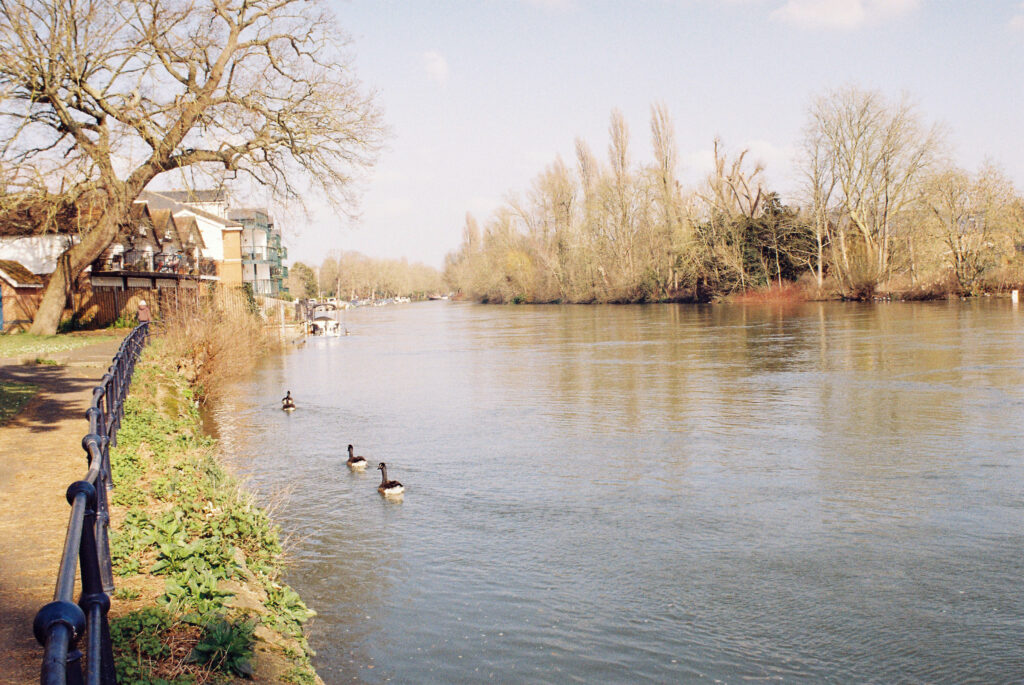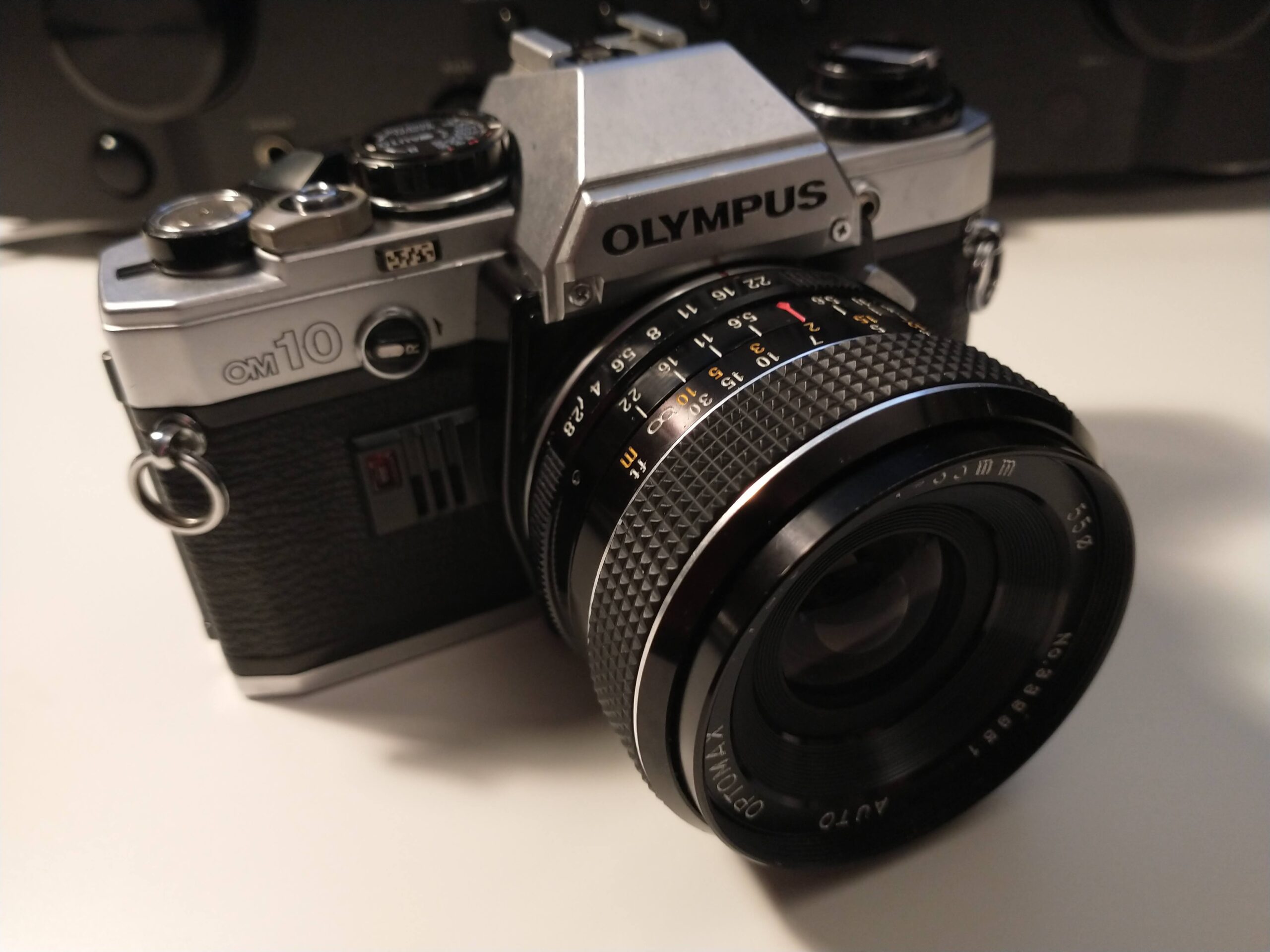A friend of mine has been doing a house clearance on behalf of a lady whose parents died. The house in question is next door to him and, as the daughter lives some distance away, he has been selling her late father’s Hi-Fi equipment and other goodies on eBay for her. One of the items was an Olympus OM10, which may have been purchased as a body, or may have had its original Zuiko lens sold off, as is sadly so often the case. The prime lens attached to this OM10 was an Optomax 35mm f2.8. I haven’t been able to find much information on this lens, but there are still examples for sale quite cheaply.
My friend is a keen (and very good) photographer, but these days he concentrates on avian photography of the digital kind. Knowing that the OM10 wouldn’t be worth the effort of auctioning, he offered it to me, free! Now I know the OM10 is viewed as the poor cheap cousin of the OM range, and only offers aperture priority unless you have the manual adapter, but how could I refuse a free camera? It also came with the T20 electronic flash, and a Vivitar 70-210mm f4.5 zoom lens (which I have yet to try).
I loaded it with Kodak Gold 200, and fired off a few shots on Christmas Day, using the flash in auto mode. Manuals for the camera and flash are readily available for download, and the pictures I took of the family on the day were perfectly exposed, at least to my eye. Highlights were not washed out, and shadow detail was clear. I did find, however, that the split image focusing was very hard to discern in room lighting and, for these flash shots, I relied on setting the approximate distance on the lens and stopping down to get good depth of focus.
Shooting a part of my back garden almost into the light, early on a frosty morning in January, I managed to get some flare, but this picture shows a surprising amount of grain. It was probably under exposed, caused by shooting towards the light and not adjusting the exposure. Schoolboy mistake, but I was getting used to the camera, so I’ll use that as an excuse!
The picture of the ’45-degree tree’ at Coalhouse Fort also shows some slight flare on the left, even though the sun was off to the left.
A couple of pictures of the River Thames at Maidenhead next. Tolerable grain on the shot of Canada geese swimming away, and exposure looks fine, but the same problem with grain on the shot of the river, facing towards the light.
Note to self: remember the basics! All pictures are ‘as-is’, after having been scanned by the processing lab, and were not post processed except for adjustment of the horizon on 1 shot.





The OM10 seems to have performed well, and is certainly easy to use. In fairness, if you had to choose between aperture or shutter priority, I guess most of us would choose aperture, unless you shoot F1 cars doing 180 mph. My main criticism is the split image focusing, but maybe that’s just me and my aging eyes. The Optomax lens is of reasonable quality, but definitely does not like shooting anywhere nearly into the light. Maybe a lens hood would sort that out, but I think I’ll try the Vivitar zoom lens next. Any comments on my grain hypothesis welcome.
Thanks for reading!
Share this post:









Comments
James Edward Hofweber on 5 Frames with a Free Olympus OM10 and Optomax 35mm Lens
Comment posted: 07/05/2024
Articles like this are why I subscribe to 35mmc.
Comment posted: 07/05/2024
Gary Smith on 5 Frames with a Free Olympus OM10 and Optomax 35mm Lens
Comment posted: 07/05/2024
Comment posted: 07/05/2024
Roger on 5 Frames with a Free Olympus OM10 and Optomax 35mm Lens
Comment posted: 07/05/2024
Are you sure the Thames shot is facing upstream? The flow around the post makes it look like downstream to me.
Comment posted: 07/05/2024
Daniel Emerson on 5 Frames with a Free Olympus OM10 and Optomax 35mm Lens
Comment posted: 07/05/2024
Your final shot of the Thames at Maidenhead looking into the light stands out for me. The back lighting darkens the foliage making a frame around the water while yielding the patterns of eddies in the water to convey the timeless motion of the water. I can place myself on the bridge in this shot, feel the breeze and hear the water as it swirls past.
Thanks for sharing.
Cheers
Daniel
Comment posted: 07/05/2024
murray leshner on 5 Frames with a Free Olympus OM10 and Optomax 35mm Lens
Comment posted: 08/05/2024
I was relieved to learn it was not one of those brands with a similar name that I think were offered on 'included advertising cards' placed in magazines before distribution. They looked like SLR's in shape only (SISO), but were made of plastic, as were the attached lens assemblies. The lens 'beauty ring', already a strange term, and a misused one in the case of these plastic cameras, had terms like Genuine Optical Lens or similar. I don't remember the cost, or they might have been free with some other purchase.
I saw one in a thrift store for USD1.00 once, yet resisted the temptation to walk faster (maintained constant velocity) and being wise beyond my years, also ignored another one for USD3.00 in a different store (can't fool this fool).
Actually, I'd say this Optomax lens is excellent compared to the above cameras, which didn't even seem to have developed a following with toy camera fans. Were they too good, or a shameful waste of plastic and genuine optical lenses?
Oh, regarding the Vivitar zoom lens, if it is a Series One lens, the initial supplier was Kino, who later made their own Kiron series of lenses, and were generally excellent at the time. Certain designs are highly respected. Several other contractors over the years were used by Vivitar, presumably to save money. Some of them are still excellent. There is a chart online, that identifies, with variable accuracy, the manufacturer codes that were typically) the first two digits of the serial number. I think I trust my memory that 22 was the code for Kino.
The optical engineers at Kino had begun using a silicone-based lubricant instead of what was the norm earlier. With clocks, horological lubricants were resistant to migration, and originally were derived from whales. Whaling declined due to responsible objection, and alternative materials including synthetics were used.
Very common over many years, the silicone-based lubricant creeps from the places it belongs and makes its way to the leaves of the aperture diaphragm or iris. If it looks wet upon visual inspection, that is a quick indicator of this phenomenon. The lens may still function normally for more years, but eventually the 'oil', which possibly might have been a grease originally, accumulates in sufficient volume and viscosity that the aperture remains 'stuck open', at full opening. If the aperture ring is rotated, the oil is stronger than the spring that pulls the aperture to the place it belongs based on the f-stop ring. Eventually the lens stays wide open regardless of the ring position. It can also fog the lens. I have two identical very costly, huge custom lenses that was confirmed by the camera service department at the company that purchased the lenses, that they were made by Kino. The one lens I had mounted in a way to use it also has a wet iris and some misty fog on the internal surface of the at least one lens element. It still operates. I have had it over 20 years. It weighs about 2 kg, and I think my current camera is about 0.8 kg. It is very awkward to hand carry. It was a portrait camera lens with a single speed electric shutter and not used outdoors. So I am using it outdoors.
Some people have figured out how to open the back section of such lenses and clean them. I am not one of those people. I purchased a few, and was given others, that ALL ended up this way. Shooting wide open is OK for a little while then I find myself not bothering reaching for them. They are a lot of work to disassemble, but I have taken clean optics subassemblies out of the front of them that are rumored to be highly corrected on their own. More short-term amusement. Luckily I didn't invest much. I think they date back to the 1970's.
Comment posted: 08/05/2024
Julian Tanase on 5 Frames with a Free Olympus OM10 and Optomax 35mm Lens
Comment posted: 08/05/2024
Good writing too, I really enjoyed it!
Comment posted: 08/05/2024
Comment posted: 08/05/2024
Paul H Trantow on 5 Frames with a Free Olympus OM10 and Optomax 35mm Lens
Comment posted: 08/05/2024
Vin on 5 Frames with a Free Olympus OM10 and Optomax 35mm Lens
Comment posted: 10/05/2024
For My main 35 mm film system the OM10 was my camera choice.
Looked at the OM10 and Pentax ME super...the pentax at the time way more expensive.
Essentially the camera body being a light tight box to hold the film, the lens quality being the business end.
I still have the original lens that came with the camera, though at the time looking at cost of lenses I opted for the Tamron adaptall 2 mount system.
My main Tamron lens was the 35 - 210 macro that I still own...one reasonable sized lens that covered most situations as opposed to a full bag of lenses.
The grain is often the lure to film photography I would usually shoot 100 iso film ( first known as asa film rating)...a choice of finer grain and controlling the manual settings.
For the contributor asking about colour rendering while scanning.
An IT8 target can help correct the colour imbalance.
I studied photography City and guilds 923 & 747...my OM 10 and Tamron lens set up more than stood its ground against Canon and Nikon cameras.
Comment posted: 10/05/2024
David Spencer on 5 Frames with a Free Olympus OM10 and Optomax 35mm Lens
Comment posted: 13/05/2024
Comment posted: 13/05/2024